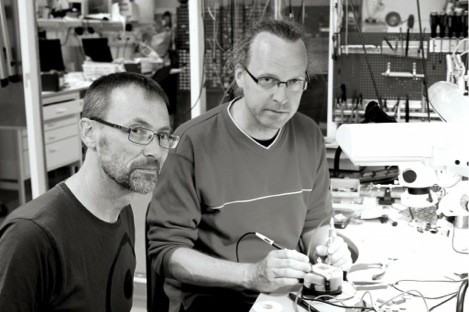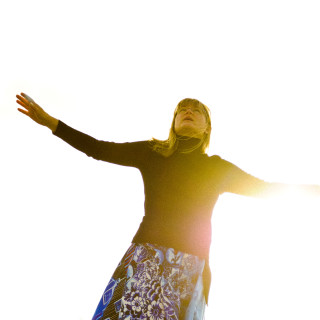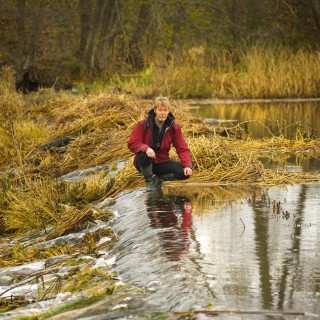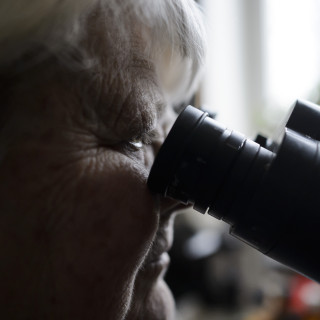Advanced technics for small creatures
Two full-time technicians help biology researchers to realise new ingenious ways of gathering data on how animals move. Thanks to computer chips, wireless communication and nanotechnology, the researchers can achieve groundbreaking results.
Arne Andersson and Johan Bäckman are the handymen behind the research in the CAnMove project.
We walk along one of the corridors on the second floor of Ekologihuset, where the two technicians Johan Bäckman and Arne Andersson have their offices alongside a large group of researchers in the CAnMove programme. Johan Bäckman looks pleased when he shows us the package of pink discs that has just arrived.
“The new super-diodes are here”, he says.
We go up another floor to CAnMove’s technical lab. There, Bäckman and Andersson work on everything from advanced electronic development to simple installations and repairs. Johan Bäckman immediately starts to unpack the pink LEDs, which will be used in one of the ongoing research projects.
The LEDs will be attached to a large water tank containing millimetre-long water fleas. The fleas have been marked using nanotechnology so that the researchers will be able to follow the movement patterns of individuals. The technical equipment opens doors to greater knowledge of the mass migration of tiny animals. It is not only larger creatures such as birds or wildebeest that are characterised by diverse migration patterns; in fact, some of the world’s most widespread animal migrations take place among very small animals, for example the huge daily migrations of zooplankton in oceans and lakes. Research on water fleas is one piece in this jigsaw.
Johan Bäckman fixes one of the new LEDs to an old computer fan, which can serve as cooling equipment for the lamp. He explains that they have a whole box of old computer fans among all the gadgets in the lab; these are the sort of thing that can come in useful in different contexts, especially in the often ad hoc process that constitutes the invention part of their job.
“We often need to do a quick test to see whether an idea is viable. In such cases it’s good to have a basic store of half-built gadgets and technical components”, says colleague Arne Andersson, adding that he has become something of a Jack-of-all-trades in his job.
Some projects require them to use existing technology, but adapt the equipment to meet the needs of the individual researcher. For example, one current project in Sweden studies lesser black-backed gulls on the small Baltic island of Stora Karlsö – a fascinating bird that migrates to tropical Africa and during the breeding season searches for food far out at sea. There was already a GPS logging system to monitor the birds, but it needed solar cells and an internet connection to the base station on the island. Arne Andersson got the job of fixing that.
In other contexts, the technicians have to develop advanced electronics that have not been made before. Arne Andersson produces a box with centimetre-wide circuit boards as an example of his own electronics design.
“This is a data logger. We’ve built four different types and written 40 versions of the software”, he says.
The data loggers can be attached to animals to provide information about how they move. It is hoped that the equipment could be used in many ways within CAnMove’s research, with researchers choosing what type of data they want to collect. Each data logger is like an extremely small computer, with a memory and capacity to collect data at regular intervals. For this type of development, Arne Andersson and Johan Bäckman make use of the technical advances in the mobile phone and computer industries, where there are components they can use in their own construction.
“There are electronic circuits that can measure acceleration, pressure, temperature, and compass direction”, says Arne Andersson.
We leave the technical lab and go for a walk around the attic of Ekologihuset. Up here, in the realm of the ventilation pipes, one of CAnMove’s many research projects is underway. The researchers are using light loggers to study swifts, a species that essentially lives its entire life in the air, apart from when it has young to care for. Swifts eat in the air, sleep in the air and even gather all the material needed for a nest in the air.
Bäckman and Andersson are also involved in this research project. They have erected web cameras in 13 bird boxes and set up a computer network that sends the images to a computer screen. When Ekologihuset was built in 1994, 144 bird boxes were installed in the attic, with the same number of holes all along the external wall. The visiting birds lay their eggs in the boxes, and the newly hatched chicks are monitored when they leave the nest 5–6 weeks later for their own adventures in the air.
Text and photo: Lena Björk Blixt
Published: 2014
Facts
-
Challenges when marking animals
-
There are a few key challenges to take into consideration when it comes to technical equipment that will be attached to the animals to be studied. Firstly, the equipment mustn’t be too heavy, as it could affect the animal’s natural behaviour. Secondly, the equipment mustn’t consume a lot of energy. Thirdly, it should be easy to transfer the data collected from the equipment attached to the animal to the researcher’s computer.
For example, the GPS logging system in the lesser black-backed gull project has wireless transmission from the bird’s back to the researcher’s computer. This type of equipment is too heavy for smaller birds, however, and they can instead be fitted with a light logger, as in the swift project. The light logger is significantly smaller and lighter, but requires the birds to be recaptured when the researcher wants to gain access to the data that has been collected by the logger. By measuring the length of the day, the light logger can provide information about the latitude of the birds, as well as their longitude thanks to a built-in clock.
-
CAnMove
-
Centre for Animal Movement Research – CAnMove
CAnMove is a centre of excellence for trans-disciplinary research on the causes and consequences of animal movements, funded by a Linnaeus grant from the Swedish Research Council and Lund University.
CAnMove research aims to resolve some of the most challenging questions in biology, such as the genetic control programs of migration, the mechanisms for animal navigation, the fluid dynamics of animal flight, and the evolution of migration. CAnMove also study dispersal and speciation, effects of movements on populations, spread of diseases and how climate change affect migrating animals.
Website: www.canmove.lu.se
Coordinator: Susanne Åkesson, phone: 046-222 37 05
Susanne.Akesson@biol.lu.se





